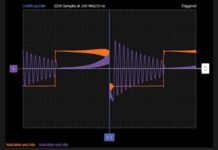Abstract
This article presents a simple and small solution for driving an LED to provide visual feedback in the presence/absence of a system’s power. The circuit consists of a resistor and a small chip, originally not intended for this purpose, which replaces a multitude of components in the conventional solution. Standalone and low power in nature, yet robust to miswiring, makes it predestined for industrial and similar systems.
Introduction
Industrial control systems universally employ 24 V DC for their field supply voltage. The presence/absence of power supply voltage is commonly signaled by LEDs found on equipment, like the controller head unit, as well as I/O and communication modules. LED supply lights aid in minimizing installation, maintenance, and downtime in industrial systems/subsystems such as programmable logic controllers (PLCs) and distributed control system (DCS) controllers, power-supply units, sensors, and actuators. Supply LEDs should light up when defined conditions are met, like voltage being in the required operating supply range. Despite their conceptual simplicity, real implementations are not that trivial. They require voltage comparators with hysteresis, need to be self-powered, and must drive LEDs consistently.
Further requirements for such circuits are:
• Low power dissipation
• The light must be off when the supply voltage is under the minimum operating voltage
• The light intensity should be invariant of supply voltage
• The circuit should be tolerant to over voltages
• Robustness to miswiring, like negative voltages as encountered during reverse polarity
Simple circuits can exhibit significant dependence on component, temperature, and voltage variation.
Background
This LED driver circuit is based on repurposing an industrial digital input chip for a function different from its originally intended application. Industrial inputs, as commonly found in industrial control systems, are based on 24 V logic and have clearly specified input current/voltage characteristics with defined input threshold voltages. A sinking input (occasionally called a p-type input) has a pulldown current specified to be larger than 2.0 mA at the maximum input high threshold voltage of 11 V for Type 3 inputs, the most common industrial input type. In order to minimize power dissipation, today’s digital input circuits limit and tightly regulate the input current to a level just slightly above the 2.0 mA limit.
The Idea
Noticing that the 2.0 mA level coincides with common LED drive currents and that industrial digital inputs have clearly defined switching thresholds, raises the question if a chip, like the MAX22191 single-channel digital input, would be suitable for power supply monitoring and LED driving? This industrial input device is designed to drive an optoisolator via its OUT pin. Figure 1 shows the proposed application circuit. REXT is a current-setting resistor, allowing the OUT current to be set in the 2.0 mA to 2.6 mA range.

The internal current source has a tolerance of ±12.5 % over tem- perature, input voltage, and part to part, ensuring low power dissipation and negligible light intensity variation over supply voltage. With the current source specified OUT output voltage compliance of 5.5 V, it is possible to drive most modern LEDs. The device’s 110 μA (typ) supply current ensures low power dissipation of the solution.
Figure 2 shows that the LED current turns on sharply at 9 V (typ) and turns off at 8 V (typ), providing 1 V hysteresis. The max-on and min-off threshold voltages are specified in the MAX22191 data sheet. Should higher threshold voltages be required, a resistor can be placed in series with the IN input, RIN, as shown in Figure 3. The RIN value is calculated as RIN = (threshold voltage increase)/IIN.
The LED current is flat with input voltage variation in the on-state, as seen in Figure 2. This contrasts to the use of a simple bipolar/MOS transistor for driving the LED, which shows significantly higher current-voltage dependence due to the transistor’s Early voltage.

LED Control
For application cases where the LED needs to be turned on/off under logic control, the TEST input can be conveniently used, as shown in Figure 3. This allows implementing auxiliary functions like power-up delays, blinking, or other status feedback.

Robustness
The solution is specified for use over the –40°C to +125°C operating temperature range. The IN supply voltage is tolerant to a wide voltage range of –70 V to +60 V, which provides headroom for surge protection and robustness to reverse polarity miswiring. In the event of reverse connection, the circuit has a low 1 μA input current in case of a negative input voltage.
Conclusion
The MAX22191 provides a simple means for LED power sup- ply indication applications. Its SOT23 package and low power current-setting resistor constitute a small solution size.
About the Author
Reinhardt Wagner is a distinguished engineer with Analog Devices in Munich, Germany. Originally with Maxim Integrated and now in ADI’s Industrial Automation Group, his 21 year tenure primarily involved the product definition of new industrial chips in the areas of communication and input/output devices, like IO-Link, fast digital I/Os, Beyond-the RailsTM analog switches, and digital isolation.
















